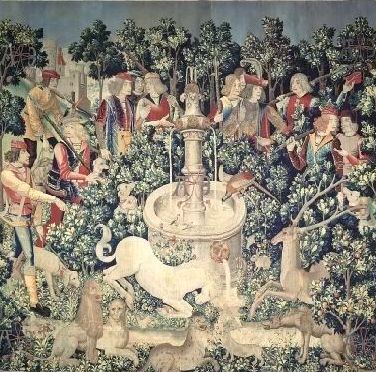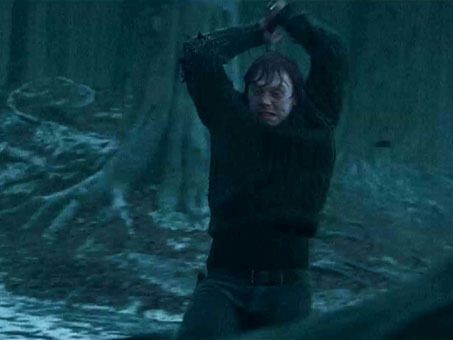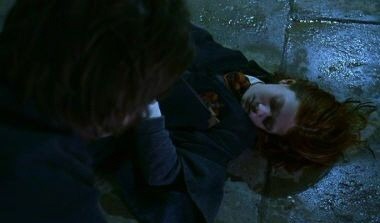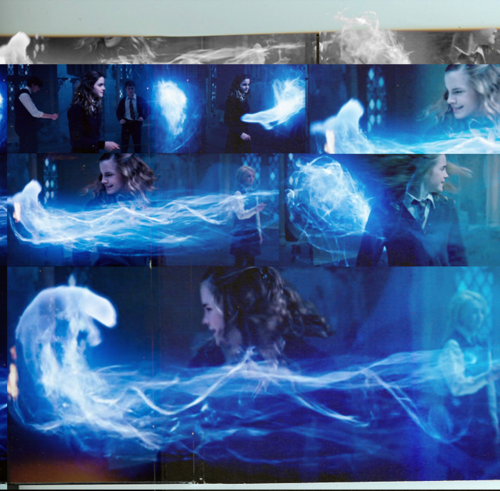Harry Potter and the Bestiary of Christ Part Five: Weasley Is Our King!
This is the final blog post of "Harry Potter and the Bestiary of Christ." If you have not done so already, please read parts 1-4 of this series. (Note: This final installment is an updated version of a blog post that I originally made in the summer of 2010.)
Weasley is Our King!

The Unicorn Is Found.
In The Hunt of the Unicorn as an Allegory of the Passion, the tapestry entitled "The Unicorn is Found," depicts the unicorn dipping its horn into a stream to purify it. The unicorn, a Christ figure, is surrounded by other animals, some of which are Christ symbols as well, such as the lion and the stag. But standing near the stream closest to the unicorn's horn is a small, slender creature which may represent a genet, an ermine, or a weasel. The much-maligned weasel is a favorite animal of author J. K. Rowling.

The Weasel, Enemy of Serpents
"Ron was the only one of three major characters whose surname never changed; he has been 'Weasley' from start to finish. In Britain and Ireland the weasel has a bad reputation as an unfortunate, even malevolent, animal. However, since childhood I have had a great fondness for the family mustelidae; not so much malignant as maligned, in my opinion."–J. K. Rowling in "Some Random Facts About the Weasley Family" at http://www.jkrowling.com/
Generally speaking, calling someone a "weasel" is usually an insult. Indeed, there are numerous examples of Draco Malfoy calling Harry's best friend Ron Weasley such insulting names as "the weasel" or "the weasel king." In Harry Potter and the Order of the Phoenix, the Slytherins mock Ron Weasley with badges that proclaim "Weasley is Our King!" sarcastically and sing a song by the same title which has lyrics that insult Ron's Quidditch-playing skills and make fun of his family's poverty.
The Bestiary of Christ reveals a totally different perception of weasels. "Although the weasel is the smallest of carnivores, it can win combats with much bigger animals than itself," thus "the weasel is the perfect symbol of a Christian who, no matter how weak in himself, can still triumph over Satan, the most terrifying monster of hell." (Bestiary 147) This passage calls to memory the scene in Harry Potter and the Deathly Hallows in which Ron must confront his deepest fears and insecurities when he is tempted by the locket of Slytherin Horcrux, which contained a fragment of the Dark Lord's soul. Voldemort spoke to Ron in this scene as a deceiver and a tempter, just as the Father of Lies, Satan, deceives and tempts the Christain to sin. But like the Christian who is weak in himself and yet with God's help can triumph over Satan, Ron, with Harry's encouragement, rejected Voldemort's lies and used the Sword of Godric Gryffindor to destroy the locket Horcrux.

Ron Destroys the Locket Horcrux.
The Bestiary of Christ also describes the weasel as the "symbol of the perfect disciple;" Ron is Harry's devoted follower, sidekick, and best friend. The weasel is also described as a "symbol of paternal affection," reminding the reader of Molly and Arthur's great love for their children.
Weasels are said to be the enemies of rats (Peter Pettigrew) and snakes (Slytherin bullies, Death Eaters, and Lord Voldemort himself). The Bestiary also describes the weasel as "the most implacable vanquisher of that terrifying reptile, the basilisk…" (Bestiary 148-149).
According to this legend, the weasel must sacrifice its own life to slay the basilisk. In Harry Potter and the Chamber of Secrets, Ginny Weasley almost loses her life in the basilisk's lair. She is saved only when Harry slays the basilisk with the Sword of Gryffindor and uses one of the creature's fangs to destroy the diary Horcrux, thus freeing Ginny from Tom Riddle's enchantment.

Another bit of weasel lore known to J. K. Rowling is that "Weasels are careful to feed on rue before fighting with snakes…" (Bestiary 150) In Harry Potter and the Half-Blood Prince, the poison that Draco Malfoy intended for Dumbledore was mistakenly consumed by Ron Weasley (an example of a weasel being poisoned by a serpent). During Ron's recovery in the hospital wing, Madame Pomfrey gave Ron essence of rue as an antidote to the poison.

Weasels who have been poisoned by serpents must ingest rue in order to recover.
The Bestiary also mentions a type of weasel called the ermine, whose brown coat turns white in the winter. The ermine, due to its white color, symbolizes purity, especially feminine virtue. The ermine's white coat disappears into the snow in the winter months and re-appears in the spring when its fur turns brown again. For this reason the ermine was a symbol of death and resurrection. Please make note the presence of the letters e-r-m-i-n-e in Hermione's name. What do you think of when Ron mumbles her name in his sleep as "Er-my-nee"? Er-mi-ne?
Otters are also part of the weasel family, so it's no surprise that the Weasleys live near the village of Ottery-St.Catchpole, and that Hermione, the eventual wife of Ronald Weasley, has an otter patronus. In Christian art, the otter is sometimes used as a symbol of Christ's righteousness. (Apostolos-Cappadonna 263).

Hermione's Otter Patronus by milkydreamsxxx on Tumblr.
In The Unicorn Tapestries the weasel appears alongside its peers: it is as courageous as the lion, as pure as the unicorn, as nurturing as the deer, and like its fellows, it is the sworn enemy of the serpent. Ron and his family have been well named indeed.

If you would like to read more, you can obtain a copy of The Lord of the Hallows: Christian Symbolism and Themes in J. K. Rowling's Harry Potter from my publisher's website at www.outskritspress.com/thelordofthehallows.
Comments on this post are welcome!












